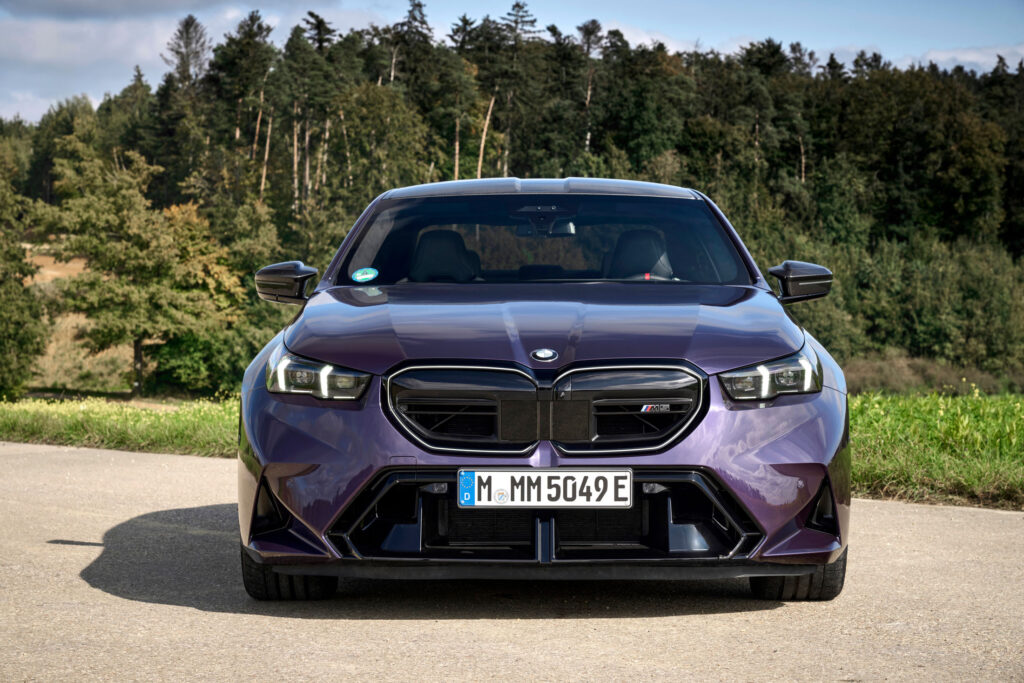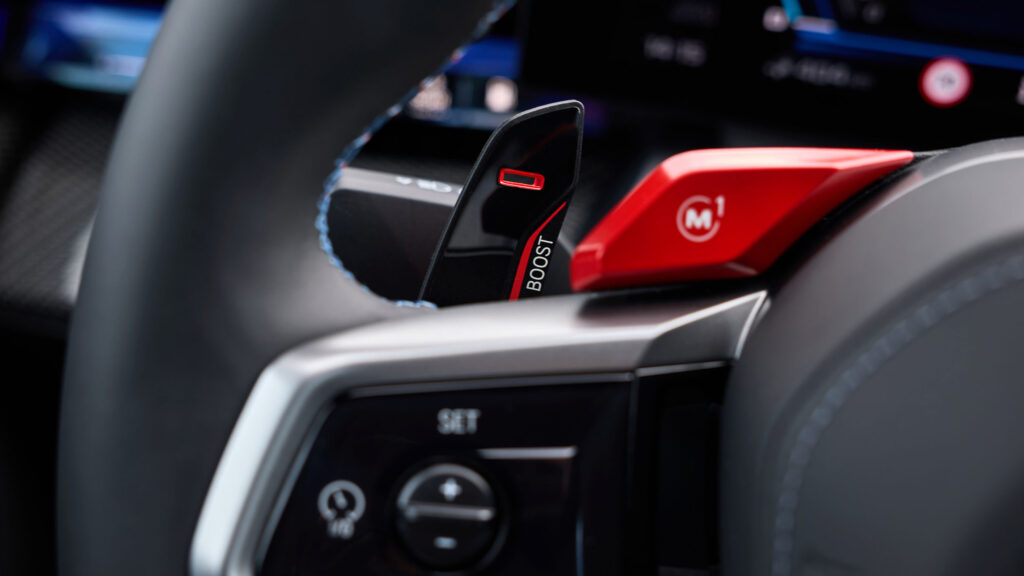
The seventh-generation M5 sticks with V8 power but adds PHEV assistance and a load of weight with it
2 hours ago
The BMW M5 is the world’s most famous sleeper, a sensible-looking sedan that can out-hustle plenty of sports cars when the road turns twisty and then go back to being a refined business express when those curves straighten out. But the seventh-generation M5 is even more versatile.
For 2025 the super-sedan is all new, and it’s no longer just a sedan. A wagon option returns to BMW’s catalog after a 15-year layoff, and this time the Touring is also available in the US, where it goes some way to compensate for BMW NA’s decision not to import the M3 Touring.
The other big news is the $119,500 M5’s first ever hybrid engine. Plug-in hardware delivers a big jump in power and the chance to drive in EV mode, but saddles the M5 with a 5,390 lb (2,435 kg) curb weight. Does that ruin the driving experience? We jumped behind the wheel of the sedan to find out.
Quick Facts

What’s under the hood?
M5s have run various different kinds of engines over the years but a bi-turbo V8 has featured in the last two models, and the format continues for 2025. The 4.4-liter combustion motor is rated at 577 hp (585 PS), down from the old M5’s 617 hp (625 PS), but that shortfall is covered – and then some – by the electric motor housed inside an eight-speed automatic transmission.
Adding its 194 hp (197 PS) and 207 lb-ft (290 Nm) of torque (boosted to 332 lb-ft / 450 Nm via pre-stage gearing), gives a total system output of 717 hp (727 PS) and 738 lb-ft, which is a big fat 1,000 Nm of metric torque. In the M5’s default mode that power is shared between all four wheels, but by playing with the menu options in the iDrive display you can send more, or even all, of the torque to the rear wheels.
How does this new hybrid engine feel and sound?

Much has been made in online forums about the new M5 taking 3.4 seconds to hit 60 mph (97 kmh) when the old M5 Competition did the job in 3.2 seconds. That’s certainly disappointing considering the power and torque gains, but out on the road the new car feels even more rapid, or maybe that should be rabid, than the model it replaces. The electric boost improves outright torque, but also response time, making the M5 feel urgent even when the turbochargers are still getting their act together.
Punch the throttle at 50mph (80kmh) and the M5 catapults forward, feeling even more explosive if you’ve set the stage by holding the left-hand shift paddle (marked boost) for a second to get the powertrain ready for maximum attack. But it’s a shame that most law-abiding American drivers won’t get to experience the way the M5 keeps on pulling and pulling with almost no letup right until the 155 mph (250 kmh) limiter intervenes. You can raise that to 190 mph (305 kmh) by paying for the optional $2,500 M Driver’s package, but unless you live in Germany where we drove the M5, there’s no point.

Less impressive than the performance is the rather flat engine noise which BMW has tried to mask by pumping synthesized sounds through the speakers. You can switch them off but you’ll be disappointed whichever way you toggle the button. The EV mode feels equally undeserving of an M5 badge. It’s got just about enough muscle to deal with city traffic, and will reach 87 mph (140 km) before the limiter calls time, but you’ll only ever feel like using it when trickling through snarl-ups.
What’s it like when the road gets wiggly?

We were all shocked when BMW revealed the new M5’s 5,390 lb curb weight, and doubly so when we realized that meant the 2025 car carried a more than 1,200 lbs (544 kg) penalty over the sedan it replaces. It’s hard not to read those figures and imagine the M5 as an underdamped, understeering mess. The reality is very different.
The M5 carves into corners with the sort of athleticism that’s hard to believe having seen that weight figure. The steering – helped by the addition of rear-axle steering for the first time on an M5 – feels fast and responsive, and also accurate, which is just as well because at 77.6 inches (1,970 mm) this is a wide car. Whether you’re throwing the M5 through some tricky left-right transitions or needing to shed a load of mph in a hurry you never feel like the weight is a problem.

And neither is a shortage of grip. The rubber has been up-sized 10 mm at both ends giving the M5 the same 285 and 295 mm-section footprints that the old CS enjoyed, but this time with an even wider track. You have to push hard at road speeds to nudge the nose wide, and in the all-wheel drive system’s default configuration the rear’s not interested in budging either. That makes it easy to cover ground at huge speeds without getting your palms too sweaty, but the more rear-biased 4WD Sport mode and the less intrusive ESC setting that comes with it is more fun, without requiring as many brave pills as the fully rear-drive mode requires.
Life with an M5 isn’t all about going fast and smoking the tires, of course. It also needs to cruise well, and it does. The ride quality is a little firmer than what you’d get in a dedicated luxury car that didn’t have to double as a Cayman hunter, but it’s fine on all but the nastiest broken asphalt.
How’s the interior?

A dedicated sports car might draw away from the M5 on a really narrow road, but it can’t eat up daily miles or long distances like a super-sedan, and the M5 feels even more capable in that respect than the last car.
The sports seats offer enough support to match the cornering power but aren’t so heavily bolstered that they’re a pain to get in and out of in daily use, and we can’t imagine many people struggling to find a good driving position. They might, however, struggle to reach the extreme right of the excellent infotainment screen, and to cope with the endless driving mode combinations, but as on the last M5 you can store your favorite combos ready to be accessed via the M1 and M2 buttons on the flat-bottom steering wheel.

Room in the back seats is good but the battery under the rear floor results in a slightly shallow footwell. And although you can fold the backrest down to increase the space available in the trunk, if you’re thinking of needing that facility you ought to be looking at the vastly more practical (and to our eyes more desirable) M5 Touring.
What else do I need to know about the new M5?

We’ve mentioned that this is the first hybrid M5 and the first time a Touring model has been offered in the US. But the G90 also marks the first appearance of flared rear fenders on an M5, something you expect on the M2 and M3.
The other thing worth knowing is that this single M5 model replaces both the base and Competition versions of the old car. There’s no CS in the lineup yet, but we expect BMW to add those two letters to a lighter, more powerful version of this M5 in the next two or three years.
BMW says the hybrid battery is rated at 43 miles (69 km) of electric range on the European WLTP cycle, but we doubt you’ll see much more than 20 miles (32 km) in real driving. You can charge it using the V8 while driving, or use the 7 kW onboard charger to fill it from flat to full in 3 hours 15 minutes, but there’s no fast-charge facility.
What are the M5’s rivals?

The M5’s most obvious rivals are the Audi RS7 and Cadillac CT5-V Blackwing, and of those we’d take the Caddy. It’s slightly less powerful then the M5 at 668 hp (677 PS), but it’s also far lighter, 0.1 second faster to 60 mph, costs $94,890 and is available with a six-speed manual transmission.
Come next year the BMW will also have to face off against a new Mercedes-AMG E63. The hot E-class also gets a PHEV engine, but unlike the M5 drops it’s V8 for an inline six, intel suggests.
Verdict

Having now driven the M5 we can safely say it’s still great to drive despite the additional weight. And experience with fast SUVs that weigh even more and have a higher center of gravity but are still fun to hustle should have told us to expect that.
We’re a bit sad that BMW felt the need to go down the PHEV route at all, rather than make another pure V8 model with more power because there aren’t as many benefits to hybrid power in the US as there are in other countries, and wealthy enthusiast drivers don’t tend to care about EV modes and saving a few bucks on gas.
You have to wonder what a non-hybrid M5 might have felt like. But the reality could have been a car that was slower than the old model and failed to meet BMW’s emissions targets – targets that, like it or not, matter to automakers and lawmakers. The bottom line is this M5 doesn’t let the badge down, and is even more versatile. We’re looking forward to trying the Touring and seeing an M5 CS further down the road.
Photos BMW, Chris Chilton / Carscoops

buy ivermectin 6 mg – purchase tegretol online cheap buy carbamazepine 400mg generic
order amoxil – buy combivent 100 mcg pills buy generic ipratropium over the counter
azithromycin cheap – buy nebivolol no prescription nebivolol without prescription
buy prednisolone generic – how to buy progesterone progesterone 100mg drug
order neurontin 800mg without prescription – buy generic sporanox itraconazole ca
furosemide 100mg generic – buy lasix online cheap diuretic buy betnovate cheap
augmentin over the counter – nizoral 200 mg price order cymbalta sale
order semaglutide 14 mg generic – buy cyproheptadine 4 mg generic cyproheptadine where to buy
tizanidine order online – order hydrochlorothiazide 25 mg generic microzide without prescription
buy tadalafil 20mg online – buy cialis 5mg order sildenafil 100mg for sale
buy generic cenforce – buy chloroquine pills buy generic glycomet online
atorvastatin 40mg pill – order norvasc generic lisinopril order
Your devotion to your art truly shows in your posts. Thank you for showcasing a piece of your artistry with us.
Thank you for taking the time to research and compile such valuable data.
prilosec 10mg price – cheap atenolol buy tenormin 100mg for sale
methylprednisolone generic – buy pregabalin 150mg pills buy aristocort medication
clarinex online order – dapoxetine 30mg brand order priligy 30mg for sale
cytotec 200mcg for sale – diltiazem 180mg canada diltiazem cheap
acyclovir pills – order crestor pill rosuvastatin pills
buy domperidone medication – domperidone 10mg uk brand cyclobenzaprine 15mg
domperidone tablet – sumycin cost buy generic flexeril online
cost warfarin 5mg – buy maxolon sale buy cozaar 50mg generic
nexium order – buy sumatriptan 50mg online cheap buy sumatriptan 25mg
order generic levofloxacin – levofloxacin 250mg over the counter buy ranitidine pill
meloxicam 15mg price – cheap celebrex buy tamsulosin 0.4mg pills
brand zofran 8mg – cheap ondansetron 8mg cost simvastatin 10mg
buy valtrex generic – buy diflucan cheap buy diflucan pill
provigil 200mg tablet order generic modafinil 200mg order provigil pill buy provigil 100mg online order generic provigil 100mg cost modafinil 100mg buy modafinil 200mg sale